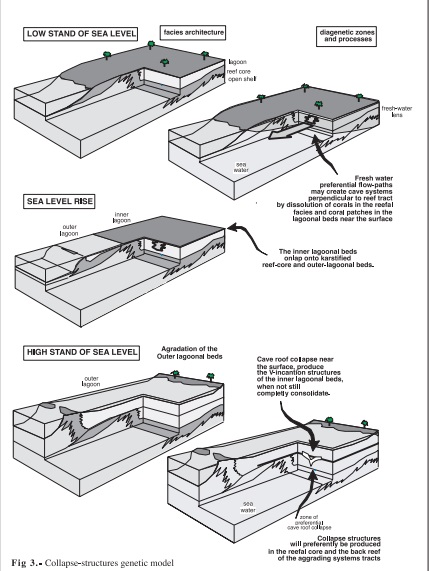Upper Miocene Karst Collapse Structures of the East Coast, Mallorca, Spain
DOI:
https://doi.org/10.3986/ac.v29i2.457Abstract
V obalnih stenah na Mallorci (Zahodno Sredozemlje) so obsežni izdanki zgornjemiocenskih karbonatnih kamnin. Na vzhodni obali otoka prekrivajo grebenski sklop mesinijski plitvovodni karbonati. Tod so v zgornjemiocenskih kamninah številne paleokraške podorne strukture. V apnence Santanyí so vrezane strukture v obliki črke V, kar kaže na udiranje stropov jam, nastalih v spodaj ležečih grebenskih sklopih. Glede na model je mogoče nastanek nekaterih izmed teh kraških podornih struktur povezati z zgodnjimi diagenetskimi procesi, na katere so vplivale pogoste spremembe nivoja morske gladine. V času nizkega nivoja morske gladine je sladkovodni tok izdolbel jamski sistem v bližini vodne gladine na tak način, da je raztapljal aragonit v frontalnem faciesu in skupke koral v obstoječih lagunskih plasteh. Ta jamski sistem se je razvijal v bližini površinske erozijske baze. Med kasnejšim dvigom morske gladine so plasti notranjega dela šelfa prekrile predhodno zakraselo jedro grebena in izvenlagunske plasti. Vrezane »V« strukture je lahko povzročila povečana teža odloženih plitvovodnih karbonatov, zaradi česar je prihajalo do gravitacijskih udiranj jamskih stropov v času, ko te plasti še niso bile popolnoma strjene.
In the sea cliffs on the Mallorca Island, Western Mediterranean there are extensive outcrops of Upper Miocene carbonate rocks. On the Eastern coast of Mallorca, the reefal complex is overlain by a Messinian shallowwater carbonate complex. There are abundant Paleokarst collapse structures. The Santanyí Limestone beds are affected by V-incasion structures produced by roof collapse of caverns developed in the underlying reefal complex. According to the model, the origin of some of these karst-collapse structures may be related to early diagenetic processes controlled by high-frequency sea-level fluctuations. During lowstands of sea level, freshwater flow might have create a cave system near the water table by dissolution of aragonite in the reef front facies and coral patches existing in the lagoonal beds. This cave system developed near the subaerial erosion surface. During subsequent rise of sea level inner-shelf beds overlaid the previously karstified reef-core and outer-lagoonal beds. Increase of loading by subsequent accretion of the shallow-water carbonates might have produced V-incasion structures by gravitational collapse of cave roofs when these beds were still not completely consolidated.
Downloads

Downloads
Published
How to Cite
Issue
Section
License
Authors guarantee that the work is their own original creation and does not infringe any statutory or common-law copyright or any proprietary right of any third party. In case of claims by third parties, authors commit their self to defend the interests of the publisher, and shall cover any potential costs.
More in: Submission chapter




